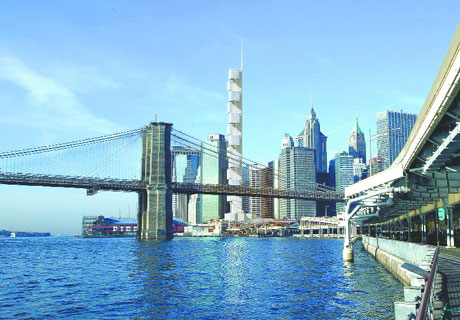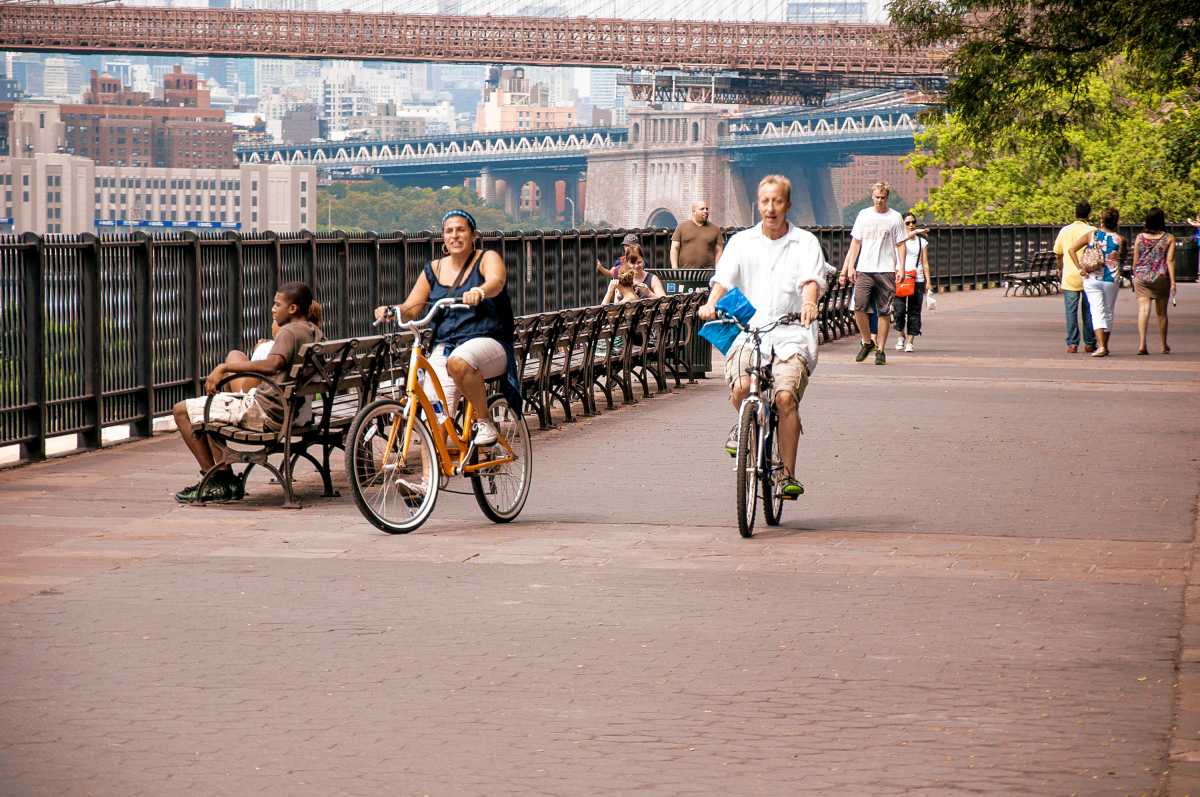By Josh Rogers
Architect Santiago Calatrava, who wowed many Downtowners with his design for the World Trade Center train station when it was unveiled in January, may be on his way to doing the same with his proposed 835-foot slender tower design in the Seaport announced on Wednesday.
The residential design described as “townhouses in the sky” received favorable reviews from some local residents who have opposed other large-scale projects in the neighborhood.
“I think it’s great,” said Barbara Marks, an architect and Seaport resident who was one of the leaders in the successful fight to change the zoning to prohibit tall buildings in the South Street Seaport Historic District. “It looks like a good design —it’s very creative. It is such a sliver that it’s not going to have a great impact on light and air…. Sometimes good design trumps other concerns.”
The building at 80 South St. is at the corner of Fletcher St. and is just outside the historic district. It is headquarters to F.J. Sciame Construction and Sciame Development, which has hired Calatrava to build the tower.
Frank Sciame, C.E.O of both firms, said construction will be expensive and complicated, but “that’s fun. That makes it interesting.” News of the project was first published in The New York Times.
The base of the building will have a museum or cultural center and a restaurant. Above the base will be 12 cubed-shaped glass townhouses attached to a central core. The cubes would be 45 feet on each side.
Sciame said that once built, the structure would be very steady, but construction would be a delicate process as each cube is attached.
“The building is classic in terms of a truss stabilizing the structure, but as you build it the cubes cantilever over the truss and it stabilizes itself as it goes,” he said.
He would not say how expensive it would be, but he said within the next few weeks he plans to apply for tax-free Liberty Bonds to pay for at least the cultural-restaurant base of the building. The townhouses, which are expected to draw top-dollar, are likely to be sold as condos. The federal bond program was set up after the Sept. 11 attacks to help Lower Manhattan recover economically. Liberty Bond residential projects are generally not allowed for condos so Sciame may not get the bonds for the entire structure unless he changes it to rental.
Bettina Damiani of Good Jobs New York, one of the organizations that has opposed many Liberty Bond projects because they have not been targeted for affordable housing, said it sounded like this would be another poor use of Liberty Bonds. She said even if it’s used to build a museum, retail or a restaurant, it would not lead to a lot of quality jobs. “What kind of jobs are going to be created out of this,” she asked. “It is going to be $5.15 an hour jobs,” she said. “Public subsidies to spur economic development need to go to a pubic benefit.”
Sciame said a significant building such as this would become a part of Downtown’s rebirth. In 2000, Sciame bought air rights from the historic district buildings. At the time, the Guggenheim was planning a museum nearby by another renowned architect, Frank Gehry. Sciame said he had discussions with Gehry about designing a building at South St., but it did not progress further. He met Calatrava two years ago, when the architect worked on a redesign of Sciame’s Park Ave. townhouse.
“In getting to know him, I became inspired by the man and his work,” said Sciame. He said when Calatrava saw how close the site was to the Brooklyn Bridge, he became excited.
“He loved the view of the Brooklyn Bridge, the Verrazano Bridge – he loves bridges so much,” sad Sciame.
Calatrava, who is also an artist an engineer, was in Europe and could not be reached for comment.
Sciame said Calatrava did 350 watercolor paintings that evolved from the artist’s previous sculptures to the current building design.
The core of the building will have the elevators and plumbing. Each townhouse, which may be divided in two, could have internal elevators as well. The cube roofs would also serve as terraces with river views.
Sciame said the restaurant would have a roof top garden area which would be about 100 feet above the street. The cultural space would be about 60,000 to 80,000 square feet of space.
The building will be 175,00 square feet and since it is so narrow, it has a high floor area ratio, 21.6. Sciame said with his additional air rights, he thinks he’ll be able to build without getting any sort of zoning variance.
It will take about 18 months to build and after saying he would start in 2005, Sciame immediately amended that to 2006. “I don’t want to put too much pressure on myself I have enough of that from clients,” he said.
His construction firm has been involved in numerous well-known projects. In Lower Manhattan, Sciame Construction has done the extension to Museum of Jewish Heritage and the Millennium High School at 75 Broad St., which was converted from offices in about two months. Sciame is also part of the development team which is restoring a series of historic Seaport buildings on Front St.
Gary Fagin, another longtime resident who has fought to preserve the area, said there was much to be positive about the new structure although he did have some concerns about whether super wealthy people would be interested in living in the neighborhood for many years.
He also wanted to make sure the cobbled stones on Fletcher St., which is not in the historic district, remain. Fagin said unlike what are commonly called cobblestones or Belgian blocks, the cobbled stones on Fletcher were individually hammered into the ground and have a different shape than most Belgian blocks.
As for the Calatrava building, Fagin said he was pleased that much of the remaining air rights would be used on this project.
“It’s going to take care of lot of the air rights threat are still hanging out there,” he said. “I like something with an iconographic texture especially since it is outside the district. It’ll look like it’s from the 21st century and it’ll make an interesting contrast to all of the 18th and 19th century buildings in the district.”
Josh@DowntownExpress.com
Reader Services


































